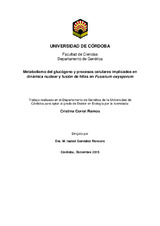Metabolismo del glucógeno y procesos celulares implicados en dinámica nuclear y fusión de hifas en Fusarium oxysporum
Autor
Corral Ramos, Cristina
Director/es
González Roncero, M. IsabelEditor
Universidad de Córdoba, UCOPressFecha
2016Materia
Fusarium oxysporum f.sp. lycopersisiTomates
Hongos patógenos
Metabolismo del glucógeno
Autofagia
Hifas
METS:
Mostrar el registro METSPREMIS:
Mostrar el registro PREMISMetadatos
Mostrar el registro completo del ítemResumen
Fusarium oxysporum f.sp. lycopersici es un hongo patógeno que infecta
la planta del tomate a través de su raíz tratándose de uno de los pocos patógenos
del suelo estudiados, que además sirve como modelo multihospedador. En este
trabajo se ha estudiado la implicación sobre la biología y virulencia de este hongo
de dos procesos relacionados con la supervivencia en condiciones limitantes: el
metabolismo del glucógeno y la autofagia.
El metabolismo del glucógeno se investigó mediante la inactivación
dirigida de los genes responsables de la biosíntesis del glucógeno: la
glucogenina (gnn1); la glucógeno sintasa (gls1) y enzima ramificadora (gbe1),
así como los implicados en la degradación: la glucógeno fosforilasa (gph1) y la
enzima desramificadora (gdb1). No se detectó acumulación de glucógeno en los
mutantes de la biosíntesis, mientras que aumentó entre un 20-40% y 80%
respectivamente, con respecto al silvestre en los mutantes simples y dobles en
los genes del catabolismo. La transcripción de los genes del metabolismo del
glucógeno durante la infección en planta alcanzó el máximo a los 4 días, de
manera similar a lo observado durante el crecimiento en cultivo axénico. Por otro
lado, los mutantes afectados en gdb1 redujeron significativamente la fusión entre
hifas en comparación con el silvestre, correlacionando con menor formación de
agregados durante el crecimiento en medio de aglutinación. Además, todos los
mutantes mostraron similar patrón de virulencia en el modelo animal
invertebrado Galleria mellonella. Curiosamente, sólo los mutantes Δgdb1
mostraron virulencia reducida durante la infección en planta, un 40% en
comparación con el silvestre.
Por otro lado, en F. oxysporum, la fusión entre hifas vegetativas
desencadena la división nuclear en la hifa invasora, seguida por la migración de
un núcleo a la hifa receptora y la degradación del núcleo residente. En este
trabajo hemos examinado el papel de la autofagia en la degradación nuclear
inducida por fusión. Mediante la búsqueda in silico en el genoma de F.
oxysporum, se identificaron 16 genes implicados en la ruta central de la
autofagia, incluida la proteína Atg8 necesaria para la formación de la membrana
autofagosomal. Se generaron mutantes Δatg8 sobre un fondo genético en el que... Fusarium oxysporum f.sp. lycopersici is a pathogenic fungus that infects
tomato plants through the roots, it is one of the few soil pathogens studied, that
also acts as multihost. In this work we have studied the implication of two
processes related with survival to limiting conditions, glycogen metabolism and
autophagy, over the fungus biology and virulence.
Glycogen metabolism has been investigated by targeted inactivation of
the genes responsible for glycogen biosynthesis: the glycogenin (gnn1);
glycogen synthase (gls1) and branching enzyme (gbe1), and the genes involved
in degradation: glycogen phosphorylase (gph1) and debranching enzyme (gdb1).
Glycogen accumulation was abolished in mutants lacking biosynthesis genes,
whereas it increased by 20–40% or 80%, respectively, in the single and double
mutants affected in catabolic genes. The transcription of glycogen metabolism
genes during plant infection peaked after 4 days, similar to it was observed during
growth in culture media. Furthermore, the mutants affected in gdb1 reduced
significantly hyphal fusion compared to wild and correlating with formation of
slightly smaller aggregates during growth in agglutination media. Furthermore, all
mutants showed similar levels of virulence in the invertebrate animal model
Galleria mellonella. Interestingly, only the mutant Δgdb1 reduced virulence during
plant infection, up to 40% compared to the wild type.
On the other hand, in F. oxysporum, vegetative hyphal fusion triggers
nuclear division in the invading hypha followed by migration of a nucleus into the
receptor hypha and degradation of the resident nucleus. In this study we
examined the role of autophagy in fusion-induced nuclear degradation. By
searching the genome of F. oxysporum we identified 16 genes involved in core
autophagy, including Atg8 which is required for the formation of autofagosomal
membrane. Δatg8 mutants were generated in a genetic background where the
H1 histone is fused to cherry fluorescent protein (CHFP) to facilitate analysis of
nuclear dynamics. The Δatg8 mutants did not show MDC-positive staining
without nitrogen source suggesting that Atg8 is indispensable for the
development of autophagy in F. oxysporum. In contrast to wild type, hyphae of
the Δatg8 mutants showed a significant fraction of compartments with more than...

